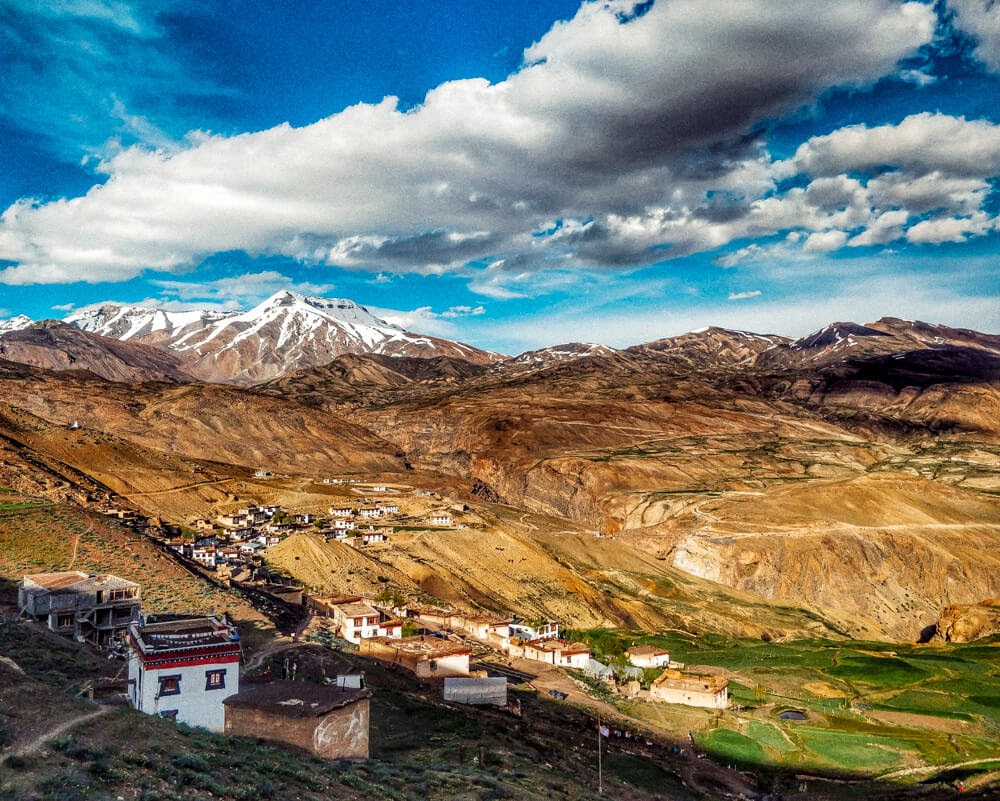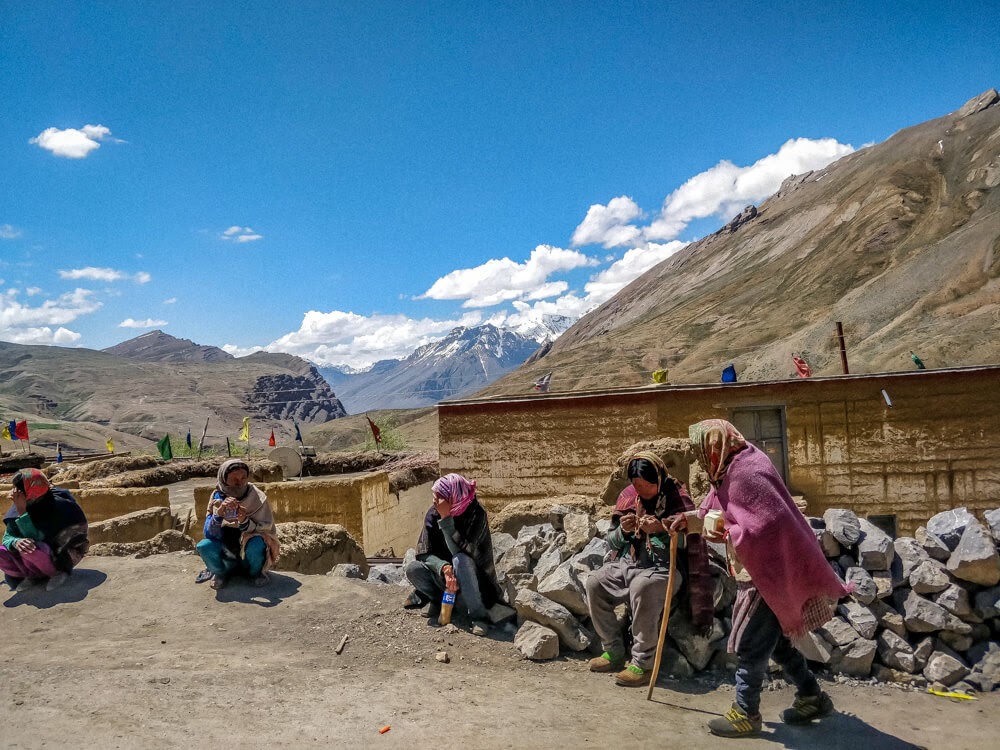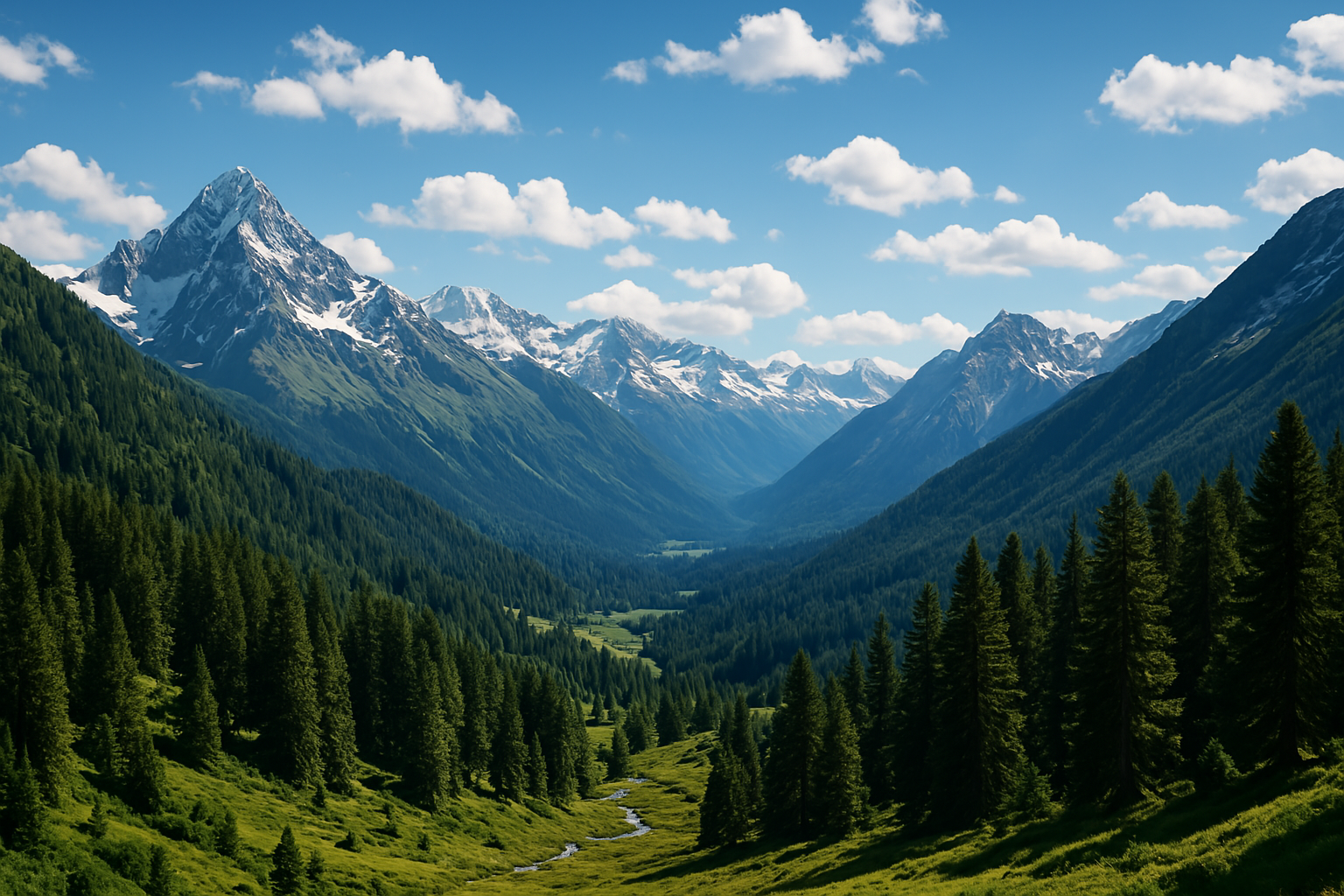
Share this:
Spiti Valley is every traveler’s dream.
Why? Because Spiti is stunning.
Have you traveled to the Himalayas yet? Maybe you went on to a travel trip to Dharamshala, explored the many places to visit near Manali, or hiked to the Chandrashila peak in Himachal Pradesh. Or perhaps you visited Uttarakhand: Mussoorie, Landour, Dehradun, or trekked in the valley of flowers.
Vast green pastures, sheep and cow grazing on lush grass, high vegetation-rich mountains, dense jungles, orchards, farms and villages, English houses, churches — this is the typical scene in Himachal and Uttarakhand.
Though Spiti is one of the many Himachal Pradesh valleys, it is nothing like this.
In this Spiti valley trip guide, we will see Spiti is one of the most bizarre and gorgeous places on this planet. The altitude of Spiti is at least 4,000 meters even in the lowest parts of the valley. And don’t forget that Spiti is a Himalayan valley. The high altitude and the Himalayas make Spiti a unique place to live.
Here are some real and raw Spiti Valley images to show you just how isolated and silent life is up there.

What does this Spiti Valley travel guide contain?
- Solo in Spiti- My journey from Manali to Spiti, finding home stays in different Spitian villages, commuting in the valley, making my way on foot, hitchhiking, and more.
- Where is Spiti Valley?
- How to reach Spiti Valley?
- Who needs a permit for Spiti Valley?
- What could be your Spiti Valley itinerary?
- Where to stay in Spiti Valley, India?
- What to eat in Spiti?
- How is the Spiti Valley weather?
- What is the best time to visit Spiti Himachal Pradesh?
- What to pack for your trip to Spiti Valley?
- Is Spiti safe for a solo female traveler?
Getting from Manali to Spiti Valley, India
My journey from Manali to Spiti, finding home stays in different villages, experiencing local life, making my way on foot in the valley, hitchhiking, and more.
I went to Spiti in July, just when the road from Manali to Spiti had opened. As always, neither had I researched on how to travel to Spiti nor had I read any Spiti Valley blog when I arrived in Manali from Parvati valley. (PS: Kalga is a beautiful village, not to be missed in Parvati.)
As I got down at the bus station in new Manali, I enquired about a bus to Spiti at the Himachal government bus stand (HRTC). Though fellow travelers in Parvati had told me the road to Spiti valley was opened, the guy at the counter said buses to Spiti weren’t running yet and the route was closed.
I was disappointed when I should have been happy. For when a bus tried to make its way to Spiti in July, it had to return midway due to the bad roads from Manali to Spiti.
The road from Manali to Spiti valley is nasty, tour agents and bus drivers told me later.
Disappointed, I went to old Manali and decided to check with the local travel agents there. Walking in the wet narrow lanes of old Manali, I knocked the doors of many travel companies. They all told me I couldn’t, yet, visit Spiti. One of the agents even suggested that as the road to Spiti wasn’t open, I should take the Himachal Pradesh tourism bus to Leh. The journey takes two days.
I almost bought the bus ticket to Leh except the bus was full. Leh didn’t want me that time.
Tour agencies and transporters flaunting “travel to Spiti valley and Leh” posters on their glass windows fringed the lanes of old and new Manali. A couple of days later, some travel agents told me I could travel to Spiti in a shared jeep. Imagine seven (or more) people elbowing each other in a claustrophobic jeep for at least 12-13 hours — if everything went well.
No way.
Another tour company agent said I could get a seat in a big tempo traveler if I went to the new Manali bus station, waited there until a tempo from Spiti showed up, and requested the driver to take me to Spiti. He told me the vehicles going to Spiti are from Spiti — people from Manali don’t send their vehicles up as the trip is costly.
I didn’t want to wait at the bus station so I went to another travel shop. The middle-aged man at the counter called someone. After a quick conversation, he told me a tempo traveler was going to Spiti the next day and that he had bought me the best seat for fourteen hundred rupees.
“They are charging too much this time,” the kind travel agent said.
After a quick Paytm transaction, I walked out with a ticket to Spiti for the next day. I had to be on the old Manali bridge by 5 am the next morning.
Tired. Hungry. Thirsty. Excited. Anxious. I was a ball of emotions. But I prepared for my journey, ate an early dinner, said goodbyes to my friend who had done the road with me from Parvati, and went to bed.
The alarm rang at 4 am. On most days, an early alarm makes me miserable irrespective of what lies ahead in the day. And I didn’t just have to wake up but I also had to buckle up my rucksack and backpack and walk to the bridge in the dark, alone.
But the bright moon shining above in the sky made my pre-dawn walk a poetic one, rather than a scared stumble.
At the pickup point I received a call from the driver Shibhu who said a van would come to pick me up. I waited, got into an unknown car when the driver confirmed he worked with Shibhu, and hoped for the best.
Shibhu, a young Spitian, was busy tying luggage and rucksacks to the roof of the tempo traveler.
“You must keep this as it might fly off,” Shibhu said while handing my yoga mat which I had tightly strapped to my rucksack.
I didn’t get much time to wonder how a tightly-tied yoga mat could fly away for Shibhu had started the vehicle. I jumped into my single seat in the front of the tempo traveler, and thus began my Spiti valley road trip.
Shibhu soon asked me to change cars for a few minutes.
“All the cars leaving Manali for Spiti have to show a permit (which can be obtained online now) if they have passengers who are not local — everyone from outside Spiti,” Shibhu informed, “but I don’t have the permit.” I translated Shibhu’s words to the foreign passengers in our vehicle.
All Indians and foreigners changed cars to sit in Shibhu’s friend’s car (his friend had the permit). All the local Spitian passengers from the other car sat in our places.
After crossing the checkpoint everyone got back to where they belonged, and we drove on. The road leading up to Rohtang Pass takes you through green and vibrant views and is mostly safe except for a few potholes. I say mostly because Shibhu had to tilt the tempo and drive with one wheel on the road and another on a higher pavement a couple of times.
Also Read: Practical tips to learn yoga in the villages of Dharamshala – And the real meaning of yoga
We stopped for breakfast a few hours into the drive. While most people just stood by admiring the panoramic no man’s land, I stuffed myself with a grilled cheese sandwich and ginger tea. Two foreign women chatted that they get nausea on a curvy drive and so abstain from food.
When the tempo traveler swiveled up the steep mountains, I thanked the universe for being born in India. After all, I have been riding on rickety buses racing through tipsy-topsy roads since I was perhaps two years old. I’ve never seen the slightest worry on the driver’s face.
If you are driving by one of these tempo travelers to Spiti, please pee whenever you get a chance. For the Spitian drivers never stop for a bathroom break. Of course, if they halt because the road is washed away or a waterfall is thrashing down on the road, men quickly find corners or just turn around and release themselves.
But what about women and girls? You will know soon.
After driving through the velvety and white Rohtang peaks, we got into drier, rockier mountains. Vegetation disappeared. The road became rougher. The landscape turned more gravel. Now we were going through parts of the route where the snow had been cleared to make way for vehicles. The paved away snow stood on either side, sometimes as tall as the height of the car.
Water gushed freely on the roads we were climbing. Tiny rivulets ran down snowy hills. Giant waterfalls smashed down on the road and washed away most of the narrow pathway. Sometimes the road was just a collection of uneven boulders settled precariously over freezing water that rushed to meet the river.
Some waterfalls pushed the rocks that lined the road into the deep valley. At these times, Shibhu would ask us to get out of the car and drive slowly to avoid skidding on the narrow road. One wrong move and the tempo would have fallen into nothingness.
Shepherds and their flocks of sheep also walked on roads. So if we took a turn suddenly, the road disappeared leaving us staring at a few hundred sheep (at least) who stared back at us.
Icy peaks watched us from a distance. A thin river gushed at the foot of the tall hills. Glaciers shined atop hills. Water poured over from all directions. We drove on.
Related read: Hiking from Kalga village to Bhunbhuni – walking on hidden trails in Parvati Valley
We took a short lunch break at Lossar, one of the first villages of Spiti.
In the village of Lossar, the Indian flag danced in the sky. The village was a backdrop to green fields. I came to know later that most farms were pea farms as mostly nothing else grows in Spiti (barley does). A small collection of flat-roofed white houses stood silent. Everything seemed white except the red and maroon borders that ran around the homes like ribbons. Of course, the rugged mountains towered above guarding the village.
Arriving in Kaza Spiti Valley, Himachal Pradesh
“Let’s go. Kaza is further away.” Shibhu hurried to the car. We arrived in Kaza at 6:30 pm after driving for about thirteen hours.
The landscape was so unfamiliar to me I felt out of place. First, I thought I was feeling the same anxiety I get when I arrive in any place for the first time, alone. But in Spiti Valley, my apprehensions weren’t baseless — though serene, Spiti is a surreal place (at least to me).
Suggested Read: Experiences from my first solo trip to Thailand
The passengers dispersed quickly. The local travelers must have gone to their homes. The foreigners had either pre-booked guesthouses or knew their way around. But neither I knew anyone nor I had a guesthouse to go to.
I walked around the streets of Kaza and found a simple homestay near the bus stand. Kaza has many homestays, now, but earlier only a couple of homes welcomed visitors in Kaza. My homestay was managed by an old grandmother who seemed to live in the house alone. Later she told me her son and daughter-in-law visit her often.
After throwing my bags in the corner of my simple but pristine room, I went out. Small grocery and medical stores were bustling with people. Tiny roadside restaurants sold jalebis, ginger chai, and samosas. Then there were cafes and souvenir shops.
My phone hadn’t received any signal for more than a few hours by then. So I went into the BSNL shop around the corner and bought a sim card to call my family and partner.
Kaza village is divided into two parts — old and new. Houses are similar to the ones I had seen in Lossar — flat-roofed, white with red, maroon, and orange borders. Solar panels were installed on all rooftops. All the windows were square. Colorful peace and prayer flags danced with the wind around each house.
Grand canyon-like chocolate mountains with strange shapes and structures surrounded Kaza. These mountains appeared steeper than the ones in Parvati and Dharamshala. They were more barren, too.
Construction work was going on in the valley. Locals said a highway will come there.
Solo in Spiti Valley in Himachal Pradesh
Tiny Tibetan, Nepalese, and Spitian restaurants along with cosmopolitan organics cafes fringe the streets of Kaza. I quickly became the patron of one Nepalese restaurant that served delicious mushroom momos and thukpa (details later in the eat in Spiti section.)
But Kaza doesn’t have much to see. Especially as I got up early and visited the Kaza monastery and temple in the first half of the day. Just aimlessly wandering around Kaza wasn’t that nice because the sun was harsh during the day on the open Kaza land. At most places, homes or shops were being constructed. Tourists flocked most Kaza streets. Everywhere I turned I found a homestay or a guesthouse.
I wanted to get out and visit or walk to another serene village or landmark. I had heard about Key monastery before I even planned my Spiti valley solo trip. As Key monastery is one of the most historical places to visit in Spiti valley, I decided to go there hoping to understand the valley better.
Walking out of new Kaza, I crossed the BSNL center and the world’s highest petrol pump on my left. Now I was on the road to the Kibber and Chicham villages.
Each village of Spiti is connected to Kaza with only one HRTC bus every day. The inter-village buses leave from Kaza in the late afternoon and return to Kaza early next morning. The bus and its driver and conductor all sleep in the village for the night. Given the constraint bus timings, hitchhiking or hiring/driving a car or bike is the best way to travel in Spiti.
But neither I knew how to drive a car nor a bike. At first, the idea of hitchhiking alone in the extraordinary valley frightened me. I wondered how would I walk on the snaky roads rising higher and higher through the rocky mountains. Miles and miles go by before you see any human or animal soul. What if passing cars and bikes didn’t see me at a blind curve?
Someone suggested waiting for a lift at the petrol pump. I took the advice. But no one on the way to the Key monastery had space in their car.
While I waited, men working at the petrol pump, travelers in cars and bikes, and truck and transport drivers stared at me. Maybe they wondered why was I traveling solo in a valley as remote as Spiti. Or perhaps they worried about me?
After an hour, I gave up waiting. Though a Spitian man told me he would drop me at Key the next day, I decided I would take a bus to the Kibber village the next evening. Buses for that day had already left.
A Tip: Go to the taxi driver’s union near the bus stand in Kaza to get an idea of things to do in Spiti valley and for a view of the Spiti map.
Stories of Spiti, Himachal Pradesh
When I returned to my homestay, my host — whom everyone called Ammaji— offered me tea and parathas. When I asked Ammaji about her family, she said her parents died when she was young. Her husband passed away at the young age of thirty-five.
Ammaji told me her husband was in the Army and was posted in Kerala. When he went for a medical checkup for his protruded nose, the doctors told him he had cancer.
“He wrote to me in January, 91.” She remembered. “But I got the letter in April, 91.”
Ammaji walked a long distance to see her husband and took him to a guru (a lama) in Dehradun. He got better and returned to Kerala to quit the army. But while he was in Kerala his cancer returned. He died in Kaza a few months later.
“Here in the mountains we never have cancer. It is a disease of the plains. But we don’t know what happened.” She said.
Ammaji, who worked in the Kaza hospital and knew about medicine, had two small children at that time. Now both her son and daughter are grown up.
I took Ammaji’s hand in mine and told her hand was swollen.
“Gathiya, that’s what it is called.” She smiled.
She pressed my hands and said, “Your hands are like wool.”
Related Read: Ammaji Reminded me of my strong host mother in Chile.
The Gorgeous Spiti, India
Next day I went down to the river and was stunned by the gorgeous vista that lay in front of me.
The sky was blue ink spread over a canvas. Silver and grey clouds floated above like thick bundles of cotton. Purple cactus flowers stood in between the rugged mountains and me. A snow-capped mountain on my far left rested at a ninety-degree slope. . The green grass near the river smiled with golden flowers. The sun played hide and seek. Along with the sun, the shadows of the clouds danced on the mountains.
And I just stood there watching the magic of nature.




